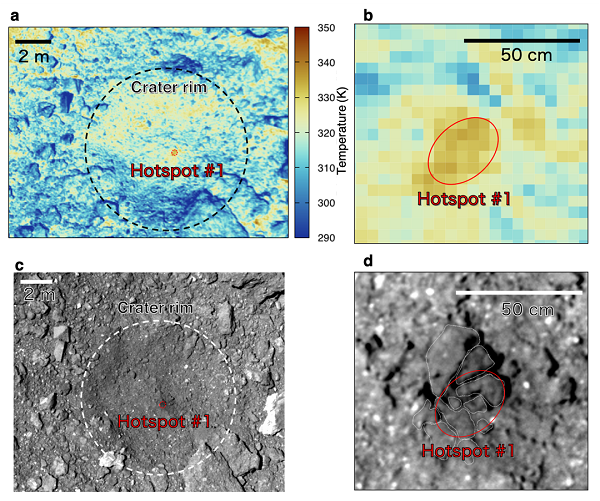DATE2021.05.27 #Press Releases
Discovery of the most primitive boulders on Ryugu
Overview of the press release
The analysis of high-resolution images captured during the close proximity operations by Hayabusa2 to asteroid Ryugu with the Thermal Infrared Camera (TIR) and the Optical Navigation Cameras (ONC) have revealed a population of ultra-high porosity boulders. These boulders are light enough that they would float on water.
Ryugu is thought to have initially formed as a fluffy planetesimal that coalesced from accumulated dust in the early Solar System, and subsequently underwent processes such as thermal evolution and compression. This parent body was then later destroyed in a collision and fragments of this reaccumulated into the asteroid. However, planetesimals have never been seen, so whether they really existed or what they may have looked like is one of the biggest challenges in understanding the planet formation process. The boulders discovered in this research are thought to be a material that most strongly retains the appearance of the fluffy planetesimals that triggered the birth of the planets in the Solar System.
Additionally, the data from all the scientific instruments onboard Hayabusa2 that were used to examine the surface of Ryugu revealed that fragments of material similar to those of the ultra-high porosity boulders are globally distributed over the asteroid surface, and may have been collected in the sample taken by Hayabusa2. If highly primitive material with the ultra-high porosity discovered here is also found in the collected samples, it will both clarify the formation and evolutional history of Ryugu’s parent body, and also provide evidence of planetesimal formation in the early stage of the Solar System formation process.

Figure 1 : TIR images (a, b) and ONC images (c, d) of the discovered high porosity boulders (hot spot area is indicated in red). The images on the right are enlargements of those on the left, and in the ONC image (d), the boulders near the hot spot are outlined in white lines. These boulders may have a very high porosity (from ©Sakatani et al., 2021).
Professor Seiji Sugita (Department of Earth and Planetary Science, Graduate School of Science), Professor Shogo Tachibana (UTokyo Organization for Planetary and Space Science), Associate Professor Tomokatsu Moroda (Department of Earth and Planetary Science, Graduate School of Science), Assistant Professor Yuichiro Cho (Department of Earth and Planetary Science, Graduate School of Science), and graduate student Kousei Yumoto (Department of Earth and Planetary Science, Graduate School of Science) also contributed to this research.
To read the full press release, please visit the website of the Japan Aerospace Exploration Agency (JAXA).
Publication details
Journal Nature Astronomy
Title Anomalously porous boulders on (162173) Ryugu as primordial materials from its parent bodyAuthors N. Sakatani*, S. Tanaka, T. Okada, T. Fukuhara, L. Riu, S. Sugita, R. Honda, T. Morota, S. Kameda, Y. Yokota, E. Tatsumi, K. Yumoto, N. Hirata, A. Miura, T. Kouyama, H. Senshu, Y. Shimaki, T. Arai, J. Takita, H. Demura, T. Sekiguchi, T. G. Müller, A. Hagermann, J. Biele, M. Grott, M. Hamm, M. Delbo, W. Neumann, M. Taguchi, Y. Ogawa, T. Matsunaga, T. Wada, S. Hasegawa, J. Helbert, N. Hirata, R. Noguchi, M. Yamada, H. Suzuki, C. Honda, K. Ogawa, M. Hayakawa, K. Yoshioka, M. Matsuoka, Y. Cho, H. Sawada, K. Kitazato, T. Iwata, M. Abe, M. Ohtake, S. Matsuura, K. Matsumoto, H. Noda, Y. Ishihara, K. Yamamoto, A. Higuchi, N. Namiki, G. Ono, T. Saiki, H. Imamura, Y. Takagi, H. Yano, K. Shirai, C. Okamoto, S. Nakazawa, Y. Iijima, M. Arakawa, K. Wada, T. Kadono, K. Ishibashi, F. Terui, S. Kikuchi, T. Yamaguchi, N. Ogawa, Y. Mimasu, K. Yoshikawa, T. Takahashi, Y. Takei, A. Fujii, H. Takeuchi, Y. Yamamoto, C. Hirose, S. Hosoda, O. Mori, T. Shimada, S. Soldini, R. Tsukizaki, M. Ozaki2, S. Tachibana, H. Ikeda, M. Ishiguro, H. Yabuta, M. Yoshikawa, S. Watanabe, and Y. Tsuda.DOI 10.1038/s41550-021-01371-7
URL


